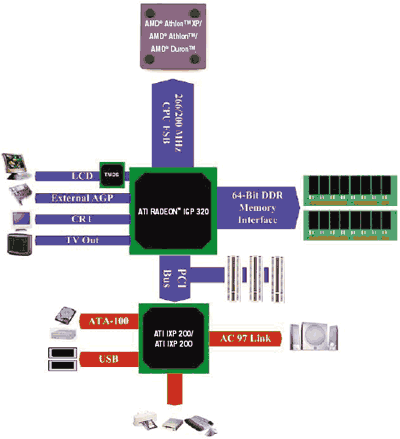Compaq Presario 900 1500+: The Radeon IGP Goes Mobile
by Matthew Witheiler on August 15, 2002 1:26 AM EST- Posted in
- Laptops
The Radeon IGP
Before we get to discussing the Compaq Presario 900 system that we got to take a look at, we thought that we would start by describing the Radeon IGP chipset. It is only thanks to this chipset that the Presario 900 is able to succeed in the mobile arena.
ATI's decision to enter the chipset market was announced on March 13, 2002 with the unveiling of no less than five northbridge solutions and two southbridge solutions. The five northbridge solutions served to target a the full range of modern Intel and AMD based processors. We spoke quite in-depth about the Radeon IGP in our Radeon IGP article. Rather than rehash all the information found in that review, we will just give a brief overview of what the Radeon IGP chipset is made up of.
The entire Radeon IGP family contains the same set of base features. These features include a single channel 64-bit DDR memory controller supporting either PC1600 or PC2100 SDRAM and a 32-bit/33MHz point-to-point link between the northbridge and ATI's own southbridge (the link happens to be backward compatible with standard 32-bit/33MHz PCI links, meaning that 3rd party southbridge solutions can be implemented). What sets the Radeon IGP apart form the competition is its integrated graphics.
All Radeon IGP northbridges contain an integrated graphics chip based on the Radeon VE core. This gives the integrated graphics core no hardware T&L support, only a single rendering pipeline, and the ability to output only three texels per clock. At the same time it also leaves the integrated graphics in the Radeon IGP family far above and beyond other integrated graphics solutions out there (with the exception of the nForce, which has yet to find its way into a mobile system). The truth of the matter is that even though the Radeon IGP is less than half a half a Radeon, it still has enough power to outdo the competition in many markets. Besides the power of the Radeon IGP, the integrated graphics on the chip also possesses some unique features.
Since the integrated graphics in the Radeon IGP is based off a Radeon design, it is equipped with a similar set of features. The means that the integrated graphics chip also features HydraVision, ATI's excellent hardware accelerated DVD playback (with iDCT and hardware motion compensation support), and HyperZ. ATI also added in its PowerPlay power saving technology to the Radeon IGP. This brings substantial power savings to the chip and makes it even more attractive to the mobile arena. Also added was an integrated video-out controller and LVDS interface.
You may be asking yourself, why a mobile chipset with integrated video? Well, finding the answer is simple. Consider how many Mobile Pentium III and Mobile Pentium III-M notebooks sold with only integrated 815EM and 830MP based graphics. A great deal of them. In fact, market data suggests that integrated graphics solutions will be found in 60% of new desktop and mobile PCs sold in 2002. To a large number of consumers out there, the difference between a "integrated video up to 64MB of shared memory" and a "NVIDIA GeForce4 440 Go/ATI Mobility 7500 with 64MB dedicated memory" is nonexistent. It is this market as well as those with limited 3D demands (such as business users) that the Radeon IGP appeals most to and frankly makes a lot of sense in.
ATI has not only licenses for AMD processors but also for Intel processors. So, although right now the Radeon IGP brings an integrated graphics chipset to the mobile AMD market (which needs it badly), ATI is also in the position to bring an integrated graphics solution to the mobile Pentium 4 market. The company has the potential to achieve much success here as well, since the only current integrated video chipset for mobile Pentium 4 processors is the seldom-used SiS 650. The two chips, the Radeon IGP 340M for the mobile Pentium 4 and the Radeon IGP 320M for the mobile AMD processors, are both pin compatable with one another. As a result, notebook manufactures should have a less bumpy ride when designing new notebooks based off either processor. The following table is a run down of ATI's northbridge solutions.
|
Chip |
Platform
|
|
Radeon
IGP 340
|
Pentium
4/Celeron (400/533MHz FSB)
|
|
Radeon
IGP 340M
|
Mobile
Pentium 4
|
|
Radeon
IGP 330
|
Pentium
4/Celeron (400MHz FSB)
|
|
Radeon
IGP 320
|
AMD
Processors (200/266MHz FSB)
|
|
Radeon
IGP 320M
|
Mobile
AMD (200/266MHz FSB)
|
Along with the five northbridge solutions announced in March, ATI also announced two southbridge chips: the IXP 200 and the IXP 250. Both chips are fairly impressive southbridge solutions that include an integrated 3Com Ethernet controller and a six port USB 2.0 controller. Over the base IXP 200, the business targeted IXP 250 includes support for remote wake on LAN, desktop management interface, ASF, and more.

The Radeon IGP system that we got a chance to look at was not actually outfitted with an ATI southbridge. Remember, the Radeon IGP northbridge can accept virtually any southbridge using a standard 32-bit/33MHz PCI link. In our case, the Presario 900 uses an ALi M1535+ southbridge solution.
Now that we know a bit more about the Radeon IGP, the enabling factor inside the Compaq Presario 900, let's take a look at the notebook.










0 Comments
View All Comments